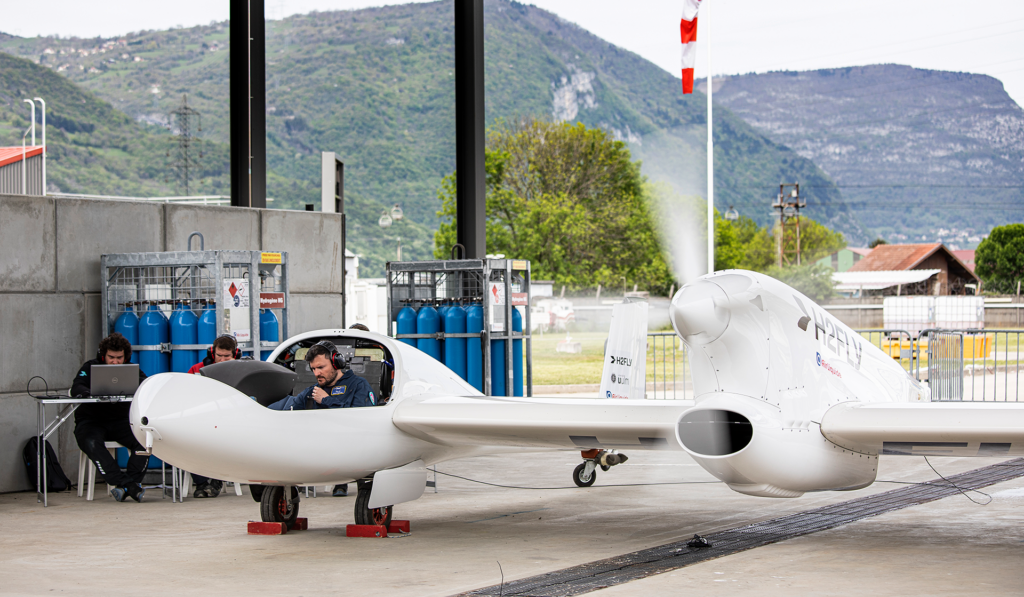- H2FLY and project partner Air Liquide successfully tested the functionality of aircraft-integrated liquid hydrogen storage system during on-ground coupling tests
- Testing was completed in preparation for H2FLY’s upcoming flight test campaign
- This world-first milestone is the latest development in the use of liquid hydrogen (LH2) to power zero-emission aircraft
Stuttgart/Sassenage, April 28, 2023 – H2FLY, the Stuttgart-based developer of hydrogen fuel cell systems for aircraft, today announced that it has successfully completed liquid hydrogen on-ground coupling tests with its HY4 aircraft for the first time. This achievement is part of the European project HEAVEN, a consortium of six companies to demonstrate the feasibility of using liquid, cryogenic hydrogen in aircraft, led by H2FLY.
The new liquid hydrogen storage system, which is designed and supplied by Air Liquide basedon H2FLY’s requirements, has been successfully coupled with the fuel cell system on ground. This coupling represents the final technological building block in the development of a complete hydrogen-electric powertrain using liquid hydrogen to power the HY4 –H2FLY’s four-seater demonstrator aircraft which runs on hydrogen and fuel cells producing zero-emissions and demonstrating the feasibility of hydrogen-electric propulsion systems foraircraft. The company led the test campaign on Air Liquide’s Campus Technologies Grenoble, in Sassenage, France together with Air Liquide.
The successful coupling tests mark another important step toward the upcoming ground and flight test campaign this summer when the HY4 is expected to be the first passenger aircraftto fly with liquid hydrogen and fuel cells.
H2FLY is the first company to successfully perform on-ground coupling tests with an aircraft-integrated LH2 tank and fuel cell system proving its pioneering technological advancements with fuel cell systems, hydrogen storage systems and H2 fuel system design for CS-23 and CS-25 aircraft. CS-23 and CS-25 are regulations established by the European Aviation Safety Agency (EASA) ensuring that aircraft meet the necessary standards for certification.
For more than 8 years, H2FLY has been researching, testing, and refining, resulting in the development of the HY4, a four-seat aircraft with hydrogen-electric propulsion, that first took flight in 2016. There have been several key milestones across the past three years, including:
- In 2020 H2FLY was granted a permit to fly the latest generation of the HY4 aircraft, which featured a fully redundant powertrain architecture. Across more than 100 take-offs the company successfully demonstrated the applicability of hydrogen-electric propulsion solutions in aviation
- In 2021 the company signed a strategic partnership with aircraft manufacturer Deutsche Aircraft that will see the companies work together to fly a CS25 class aircraft powered by H2FLY’s hydrogen fuel cell technology. The climate-neutral regional aircraft demonstrator is expected to fly in 2025
- Earlier last year, the company completed a cross-country flight, from Stuttgart, Germany to Friedrichshafen, covering 77 miles, marking the first time a hydrogen-powered passenger plane has flown between two commercial airports
- Also last year, the company set what is believed to be a world altitude record for a hydrogen aircraft, flying at 7,230 feet, confirming the company’s position as a leader in this new category
Furthermore, the company has established specialist knowledge when handling liquid hydrogen as it worked together with Air Liquide to develop new safety concepts in preparation for the coupling tests.
Prof. Dr. Josef Kallo, co-founder and CEO of H2FLY says “With the successful passing of the on-ground coupling tests, we have learnt that it will be possible to also scale up our technology for a 40-seater aircraft. We are thrilled to be making this crucial progress as we continue our efforts towards making sustainable medium and long-haul flight a reality.”
This coupling milestone follows the company’s announcement last month that it passed its first filling tests with the integrated liquid hydrogen tank.
